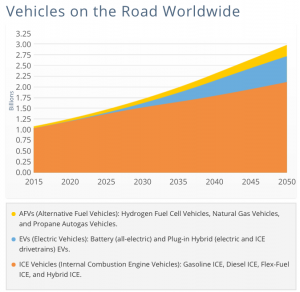What cars will we be driving in 2050?
Today, there are approximately 1.1 billion light-duty vehicles in use around the world.
About 1.2 million, or 0.1 percent of the global fleet, are all-electric or plug-in hybrids. More than 1 billion of those vehicles run on gasoline and diesel-powered internal combustion engines.
But what about the future? What will the global fleet look like 10, 20 or even 30 years from now? With all the predictions and forecasts out there concerning alternative vehicle growth rates, we decided to build a new, user-interactive Tool to model out some of these assumptions and see how they pan out long term.
Using data and research from expert groups like the International Energy Agency, Argonne National Laboratory, the U.S. Department of Energy, and the consulting firm IHS, the Tool takes assumptions on alternative vehicle growth and projects what our world’s vehicle fleet will look like through the year 2050.
Learn more: Interact with the Tool and put in your own assumptions
The findings tell a startling story: While new vehicle technologies will continue to expand, the global fleet will also keep growing and could reach over 3 billion vehicles by 2050. And even under optimistic assumptions, EVs and other alternative vehicles will make up only half the total. The other half will be comprised of internal combustion engine (ICE) vehicles that run on petroleum-based fuels like gasoline and diesel. And that’s a best-case scenario.

Considering all the threats our oil addiction poses to the U.S. economy, our national security, and air quality, these findings highlight the urgent need to go full throttle on multiple solutions at the same time. Relying on electric vehicles (EVs) or any one remedy all by itself is an irresponsible policy. We need to pursue all alternatives — including EVs, oil, and ICE vehicles running on oil alternatives like ethanol and methanol —if we’re to have any hope of meeting our transportation needs.
You don’t have to rely on our interpretation of the data. Go try out the model yourself! Check out our interactive tool here, which includes three scenarios from energy sector experts – International Energy Agency (IEA), Bloomberg, and Goldman Sachs. Or, alternatively, plug in your own numbers. We’ve also provided the full version of the Tool and our White Paper discussing the ramifications of these findings, downloadable for people who want more.
If you liked the Tool or found it useful, please be sure to share it around using the share buttons at the bottom of the page!
Related posts:

